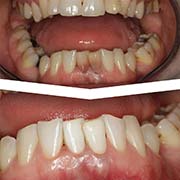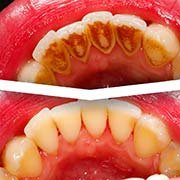What It Solves
Professional dental cleaning is the principal prophylactic measure against tooth decay and periodontal disease. During the day the surface of your teeth gets covered in food detritus and a mixture of microbes and cells that have worn away from the upper epithelial layer of the mouth’s mucous membranes, which form a whitish-grey and hard-to-detect soft layer. Since toothbrushes do not always successfully clean 100% of the surface of the teeth, the micro-organisms in deposits that stay on the teeth for a few days begin to excrete toxins that affect the gums, and can eventually cause inflammation.
Plaque deposits that are not removed become mineralised and tophus may form, which impedes the natural cleaning of the mouth and retains bacteria, thereby creating the conditions for ongoing inflammation. If the causes are not removed, the inflammation continues, with damage to dentine pockets, loss of bone tissue and loosening of the teeth, which may eventually be lost. Gingivitis is the early phase of dentine damage.
When you have this disease your gums are red, swollen, and they bleed when you brush your teeth. At this stage the disease is treatable and can be cured by correct application of individual and professional oral hygiene procedures. A more widespread disease of the gums is periodontitis, which may result in loose teeth, bone damage, loss of teeth.
Treatment of long-standing periodontitis is complex and can require considerable expenditure. In order to block the path of the afore-mentioned tooth and gum diseases, it is essential to perform a professional oral hygiene process, the goal of which is to remove soft and hard deposits (plaque and tophus), to arrest the development of caries and gum and periodontal diseases, and to refresh the buccal cavity.
How Is It Done
Commonly used first is an ultrasonic instrument which uses tickling vibrations to knock larger pieces of tartar loose. It also sprays a cooling mist of water while it works to wash away debris and keep the area at a proper temperature. Once the larger pieces of tartar are gone, the dentist will switch to finer hand tools (called scalers and curettes in dental-speak) to remove smaller deposits and smoothen the tooth surfaces.
These tools are curved and shaped to match the curves of the teeth. They allow smaller tartar deposits to be removed by carefully scraping them off with a gentle to moderate amount of pressure.
Once all the surfaces are smooth, the dental worker will polish your teeth. Polishing is done using a slow speed handpiece. Prophylaxis (short for prophy) paste — a special gritty toothpaste-like material — is scooped up and spun around on the teeth to make them shiny smooth.
Fluoride foam or gel is then placed into small, flexible foam trays and placed over the teeth for 30 seconds. The fluoride helps to strengthen the teeth since the acids from bacteria in dental tartar and plaque will have weakened the surfaces. It is best not to eat, drink or rinse for 30 minutes after the fluoride has been applied.


